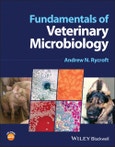A compact and accessible guidebook exploring current understanding of common bacterial and fungal pathogens of animals.
Fundamentals of Veterinary Microbiology brings together knowledge and understanding of the bacterial pathogens of animals from disease signs and diagnostic methods to the molecular basis of the host pathogen interaction. A small but focused book, it enables the reader to access important information during diagnosis and treatment in a clinically relevant way. Suitable as a companion for study on the subject and for professional use, the author focuses on the more clinically common diseases at the general and first-referral level.
Divided into three sections, the first covers the basics of bacterial microbiology such as structure, growth and genetics. The second examines the commonly encountered bacterial pathogens, with emphasis on current understanding of the cellular and molecular basis of infection and immunity. The third section explores the current state of knowledge of those fungi involved in infection of animals.
Specific topics covered in Fundamentals of Veterinary Microbiology include:
- Nutrition, sterilization, and disinfection of bacteria, bacterial genes and gene transfer, pathogenicity and host response, and vaccination
- Antimicrobials (action, dynamics, and resistance), typing and identification of pathogens, fungi as agents of disease, Salmonella and E. coli in animal disease and public health
- Pathogens transmitted by vectors such as Borrelia, those of endogenous origin such as Clostridium and Pasteurella and those able to spread widely such as Leptospira, Mycobacterium and Chlamydia
- Fungal pathogens causing superficial, subcutaneous and systemic mycoses
Fundamentals of Veterinary Microbiology is an essential resource for veterinary students, veterinary nurses, and veterinary practitioners worldwide, allowing them to quickly establish a foundation of knowledge of bacterial pathogens based on clear understanding gained from studies over recent decades.
Table of Contents
Preface xvii
About the Companion Website xix
1 The Bacterial Cell 1
2 Metabolism, Growth and Culture of Bacteria 9
3 Sterilisation and Disinfection 15
4 Bacterial Genes and Gene Transfer 23
5 Bacterial Pathogenicity 29
6 Bacterial Veterinary Vaccines 39
7 Antimicrobials: Action, Dynamics and Resistance 43
8 Bacterial Typing 51
9 Salmonella 55
10 Escherichia coli - An Intestinal Pathogen 63
11 Escherichia coli as an Extraintestinal Pathogen 69
12 Campylobacter - Hyperendemic on the Farm 75
13 Leptospira - Using Urine to Spread 81
14 Lyme Disease - Ticks and Dogs 87
15 Brachyspira 91
16 Pasteurella 93
17 Pseudomonas and Burkholderia 97
18 Bordetella 101
19 Delicate Gram-negative Bacteria 105
20 Mannheimia, Actinobacillus and Other Pasteurellaceae 111
21 Chlamydia - A Stealthy Pathogen 117
22 Bovine Tuberculosis and Johne's Disease 121
23 Bacillus anthracis 129
24 Clostridium 133
25 Staphylococcus - Skin and Soft Tissue Infection 143
26 Streptococcus 149
27 Nocardia, Actinomyces and Dermatophilus - The Filamentous Pathogens 155
28 Prescottella (Rhodococcus) equi 159
29 Corynebacterium - CLA 163
30 Listeria - Growing in the Fridge 165
31 Erysipelothrix and Trueperella 169
32 Mycoplasma - Cell-associated Pathogens 173
33 Rickettsia - Arthropod Vector-borne Pathogens 179
34 Fungi as Agents of Disease 183
35 Aspergillus - Strength in Numbers 187
36 Dermatophytes - Keratinolytic Fungi 191
37 Yeasts: Malassezia, Candida and Cryptococcus 195
38 Dimorphic Fungal Infections 199
Index 205








